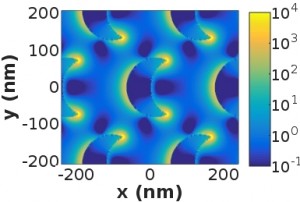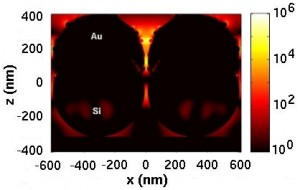Above: Highly-ordered Au-nanoparticle superlattice leads to strong plasmonic coupling together with facets leads to Fabry-Perot modes.


Nanophotonics has become a very active research field during the past decades. With the development of new technologies and control of nano fabrication techniques, an understanding of the optical of materials at the nanoscale became realized. We develop theoretical models, and use advanced numerical simulations and modeling, to investigate new optical properties of nanostructures. Working together with our experimental colleagues who are utilizing state-of-the-art spectroscopy techniques, we elucidate the mechanisms of a range of phenomena such as surface-enhanced spectroscopy on nanoparticles, plasmonic lasers, photonics of nanoparticle superlattices, and photo-induced charge transfer.
The Schatz group has been developing and using a large range of methods for solving Maxwell’s equations. We are also developing mixed quantum mechanical/electrodynamics methods for describing the spectroscopic properties of molecules on metal particles. Optical properties of interest include extinction, scattering, surface- and tip-enhanced Raman spectroscopies, and second harmonic generation. Numerical approaches such as DDA, FDTD, Mie theory, effective medium theories, and (TD)DFT are used to tackle these problems.

In addition to the fundamental understanding of plasmons, both in the quantum limit and continuum limit, the Schatz group has aided in the development of a variety technologies. Through a fostered collaborative environment, many students are able to tailor their research towards the design of optical technologies and bridge the gap from basic science to working devices. Contributions to recent technologies such as plasmonic lasers, Fabry-Perot resonantors, plasmon rulers and metamaterials has been a major achievement of the group.
Rebecca Gieseking, postdoctoral fellow
Dhara Trivedi, postdoctoral fellow
Wendu Ding, postdoctoral fellow
Adam Ashwell, 4th year graduate student joint with Mark Ratner
Weijia Wang, 3rd year graduate student joint with Teri Odom
Michael McAnally, 3rd year graduate student joint with Rick Van Duyne
Danqing Wang, 2nd year graduate student joint with Teri Odom
Marc Bourgeois, 2nd year graduate student
Recent Publications:
Park, Daniel J.; Zhang, Chuan; Ku, Jessie C.; Zhou, Yu; Schatz, George C.; Mirkin, Chad A.“Plasmonic photonic crystals realized through DNA-programmable assembly” P.N.A.S. 2015, 112, 977–981.
Valley, Nicholas; Greeneltch, Nathan; Van Duyne, Richard P.; Schatz, George C., “A Look at the Origin and Magnitude of the Chemical Contribution to the Enhancement Mechanism of Surface-Enhanced Raman Spectroscopy (SERS): Theory and Experiment”. J. Phys. Chem. Let. 2013, 4, 2599-2604.
Mullin, Jonathan; Valley, Nicholas; Blaber, Martin G.; Schatz, George C., “Combined Quantum Mechanics (TDDFT) and Classical Electrodynamics (Mie Theory) Methods for Calculating Surface Enhanced Raman and Hyper-Raman Spectra”. J. Phys. Chem. A 2102, 116, 9574-9581.
